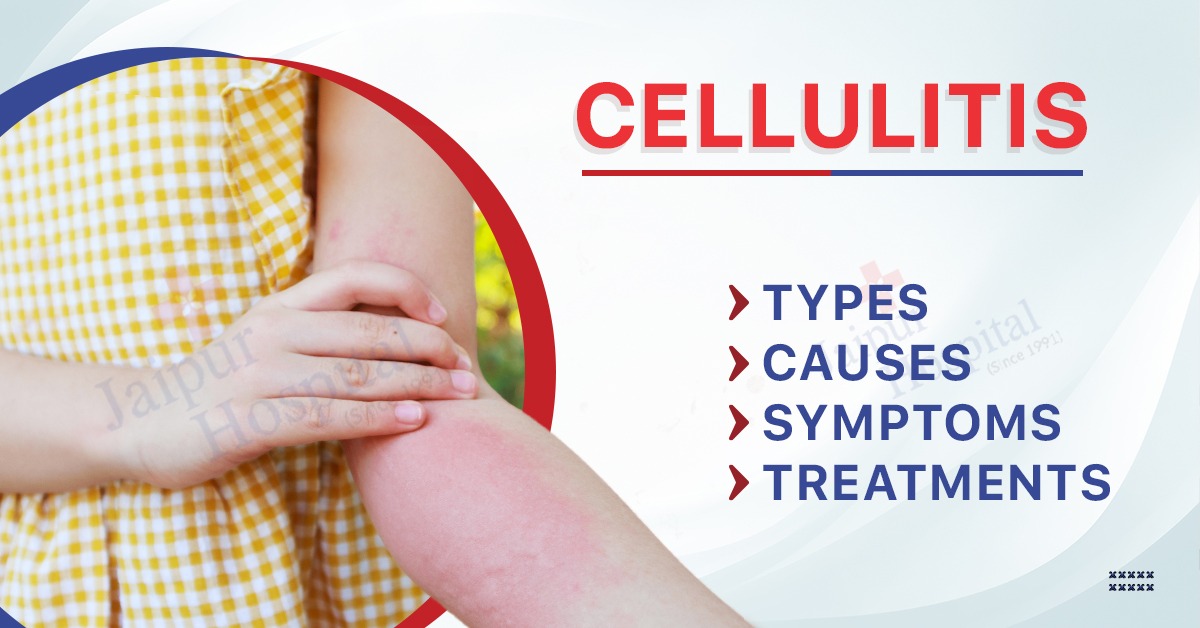What is Cellulitis?
Cellulitis is a prevalent bacterial infection that targets the deeper layers of the skin and underlying tissues, causing inflammation. It occurs when bacteria, most commonly streptococcus or staphylococcus, enter the skin through a break or crack, such as a cut, wound, or insect bite. Once the bacteria enter, they can multiply and cause an inflammatory response, resulting in the characteristic signs and symptoms of cellulitis.
Cellulitis typically appears as a red, swollen, and tender area of skin that may be warm to the touch. The affected area can expand rapidly, and the infection may spread to surrounding tissues if left untreated. It most commonly affects the legs, but it can occur anywhere on the body.
Common risk factors for cellulitis include having a compromised immune system, such as from diabetes or HIV/AIDS, a history of cellulitis or skin infections, obesity, lymphedema (a condition causing fluid retention and swelling), and certain skin conditions like eczema or athlete’s foot. People with poor circulation, such as those with varicose veins or chronic venous insufficiency, are also more prone to developing cellulitis.
If left untreated, cellulitis can lead to serious complications such as blood infections (sepsis) or the formation of an abscess. Therefore, it’s important to seek medical attention promptly if you suspect you have cellulitis.
Types of Cellulitis:
Cellulitis can be classified into different types based on certain characteristics or factors. Here are a few types of cellulitis:
- Non-necrotizing cellulitis: This is the most common type of cellulitis, characterized by inflammation and infection of the skin and subcutaneous tissues. It typically presents with redness, swelling, warmth, and tenderness in the affected area.
- Periorbital cellulitis: Also known as preseptal cellulitis, it is an infection of the eyelid and the surrounding skin. Periorbital cellulitis can occur as a result of a local infection or the spread of an infection from the sinuses or other facial structures. It causes swelling, redness, and pain around the eye.
- Orbital cellulitis: This is a more severe form of cellulitis that affects the tissues around the eye socket (orbit). It usually occurs as a complication of sinusitis or from the spread of infection from nearby structures. Orbital cellulitis can cause symptoms such as eye pain, vision changes, proptosis (bulging of the eye), fever, and restricted eye movement.
- Erysipelas: Erysipelas is a specific type of cellulitis that is characterized by well-defined, raised, and sharply demarcated borders. It often affects the face, particularly the cheeks and the area around the eyes. Erysipelas is usually caused by streptococcal bacteria and may be associated with symptoms such as fever and chills.
- Necrotizing cellulitis: This is a severe and potentially life-threatening form of cellulitis that involves rapid tissue destruction and death (necrosis) of the affected area. It is usually caused by highly aggressive bacteria, such as certain strains of streptococcus or staphylococcus. Necrotizing cellulitis requires immediate medical intervention, including surgical debridement and intravenous antibiotics.
Also read: Broken Tailbone: Causes, Symptoms, Treatment, and Recovery
Causes of Cellulitis:
Cellulitis is primarily caused by a bacterial infection, most commonly by bacteria from the streptococcus or staphylococcus species. These bacteria can enter the skin through a breach in the protective barrier, such as:
- Skin Breaks: Any break in the skin, including cuts, wounds, abrasions, surgical incisions, or puncture wounds, can provide an entry point for bacteria.
- Cracks or Fissures: Dry and cracked skin, particularly in areas like the feet, can create an opening for bacteria to enter.
- Skin Ulcers: Open sores or ulcers, often associated with underlying conditions like venous insufficiency or diabetes, can become infected with bacteria.
- Skin Conditions: Certain skin conditions like eczema, psoriasis, athlete’s foot, or fungal infections can compromise the skin’s integrity and make it more susceptible to bacterial invasion.
- Animal or Insect Bites: Bites from animals, such as dogs or cats, or insect bites, such as those from spiders or mosquitoes, can introduce bacteria into the skin.
- Foreign Objects: If foreign objects, such as splinters or thorns, penetrate the skin, they can introduce bacteria and trigger cellulitis.
- Pre-existing Infections: Existing skin infections, such as impetigo (a contagious skin infection), can progress and lead to cellulitis.
Symptoms of Cellulitis:
Cellulitis typically presents with several characteristic signs and symptoms. These may vary depending on the severity and location of the infection. Common symptoms of cellulitis include:
- Redness: The affected area of the skin appears red and may have a distinct, spreading pattern.
- Swelling: Swelling and edema occur in the affected area, often causing the skin to feel tight and stretched.
- Warmth: The skin over the infected area is warm to the touch due to the inflammatory response.
- Tenderness: The affected area is tender or painful when touched or pressed.
- Pain: Cellulitis can cause localized pain or discomfort in the affected area.
- Skin Texture Changes: The skin may appear shiny or stretched due to swelling, and it may feel tight or thickened.
- Fever: In some cases, cellulitis can be accompanied by fever and chills, particularly when the infection is more severe or systemic.
- Lymph Node Enlargement: The lymph nodes of nearby skin may become swollen and tender.
- Blisters or Pus: In more severe cases or when the infection progresses, blisters or areas of pus may develop on the skin surface.
It’s important to note that cellulitis symptoms can vary depending on the location of the infection. For example, if cellulitis affects the face, symptoms may include eye redness, pain, and swelling. If it affects the leg, symptoms may include leg pain, difficulty walking, and swollen lymph nodes in the groin area.
Diagnosis of Cellulitis:
The diagnosis of cellulitis is typically made by a healthcare professional based on a combination of clinical evaluation, medical history, and sometimes additional tests. Here’s an overview of the diagnostic process for cellulitis:
- Physical Examination: The doctor will examine the affected area of the skin and look for characteristic signs of cellulitis, such as redness, swelling, warmth, and tenderness. They may also assess the borders of the affected area to determine the extent of the infection.
- Medical History: The doctor will inquire about your medical history, including any previous episodes of cellulitis, underlying medical conditions, recent injuries or skin trauma, and risk factors that may contribute to the development of cellulitis.
- Laboratory Tests: While not always necessary, laboratory tests may be performed to support the diagnosis or identify the specific bacteria causing the infection. These may include:
- Blood tests: A complete blood count (CBC) may be conducted to check for an elevated white blood cell count, which indicates an infection. Blood cultures may also be taken to identify the causative bacteria.
- Wound culture: If there is an open wound or abscess associated with the cellulitis, a sample of the wound may be collected and sent to the laboratory for culture and sensitivity testing. This helps determine the specific bacteria causing the infection and which antibiotics are most effective against it.
- Imaging Studies: In certain cases, imaging studies may be recommended to assess the extent of the infection or to rule out underlying complications. This may involve X-rays, ultrasound, or magnetic resonance imaging (MRI), particularly if there is concern about the involvement of deeper tissues or structures.
It’s important to consult a healthcare professional for an accurate diagnosis of cellulitis. Other conditions, such as deep vein thrombosis, contact dermatitis, or skin abscesses, may present with similar symptoms, so a proper evaluation is necessary to determine the underlying cause and guide appropriate treatment.
Risk Factors of Cellulitis:
It’s worth noting that certain factors can increase the risk of developing cellulitis. These risk factors include:
- Weakened Immune System: Individuals with compromised immune systems, such as those with HIV/AIDS, undergoing chemotherapy, or taking immunosuppressive medications, are more susceptible to bacterial infections, including cellulitis.
- Chronic Conditions: Conditions that affect blood circulation, such as diabetes, venous insufficiency, or lymphedema, can impair the skin’s ability to fight off infections.
- Obesity: Excess weight can put additional strain on the lymphatic system and compromise immune function, making individuals more prone to cellulitis.
- Age: Older adults and young children have a higher risk of developing cellulitis due to their relatively weaker immune systems and thinner skin.
It’s important to note that while bacteria are the primary cause of cellulitis, there are rare instances where fungal or viral infections can mimic cellulitis symptoms. Proper diagnosis by a healthcare professional is crucial for appropriate treatment.
Complications of Cellulitis:
Cellulitis, if left untreated or not effectively managed, can lead to several complications. These complications can vary from person to person and may include:
- Abscess Formation: In some cases, cellulitis can progress and result in the formation of an abscess, which is a collection of pus. Abscesses typically require drainage and may necessitate surgical intervention.
- Spread of Infection: If the infection spreads beyond the initial site of cellulitis, it can affect deeper tissues, such as muscles, fascia, or even the bloodstream. This can lead to severe complications, including sepsis (a systemic infection), osteomyelitis (bone infection), or meningitis (infection of the membranes surrounding the brain and spinal cord).
- Recurrent Cellulitis: Some individuals may experience recurrent episodes of cellulitis, especially if there are underlying risk factors or predisposing conditions. Recurrence can increase the risk of complications and may require further investigation and preventive measures.
- Lymphangitis and Lymphedema: Cellulitis can impair normal lymphatic drainage, leading to lymphangitis (inflammation of lymphatic vessels) and lymphedema (chronic swelling caused by fluid retention). These conditions can cause long-term discomfort and may require specialized management.
- Chronic Cellulitis: In some cases, cellulitis may become chronic, with persistent or recurrent infections in the same area. Chronic cellulitis can result in skin changes, such as thickening, hardening, and discoloration.
- Functional Impairment: Severe or recurrent cellulitis, particularly when it affects the limbs, can result in functional impairment. It may cause difficulties with mobility, joint stiffness, or reduced range of motion in the affected area.
- Psychosocial Impact: Cellulitis, especially when it occurs in visible areas or affects body image, can have a psychosocial impact on individuals. It may lead to emotional distress, self-consciousness, or decreased quality of life.
Treatment of cellulitis:
The treatment of cellulitis typically involves a combination of antibiotics, supportive care, and measures to promote healing. Here is an overview of the common approaches to cellulitis treatment:
- Antibiotics: Antibiotics are the mainstay of cellulitis treatment and are used to eradicate bacterial infection. The choice of antibiotics depends on various factors, including the severity of the infection, the suspected bacteria involved, and any underlying health conditions. In less severe cases, oral antibiotics may be prescribed, while more severe or systemic infections may require intravenous antibiotics administered in a hospital setting. It’s important to complete the full course of antibiotics as prescribed, even if the symptoms improve, to ensure the infection is completely cleared.
- Supportive Care: To relieve symptoms and aid recovery, supportive care measures may include:
- Elevation: Keeping the affected area elevated, such as raising the leg if the cellulitis is in the lower extremities, can help reduce swelling and improve circulation.
- Warm Compresses: Applying warm compresses to the affected area can help alleviate pain, promote blood flow, and reduce swelling.
- Pain Relief: Over-the-counter pain relievers such as acetaminophen or nonsteroidal anti-inflammatory drugs (NSAIDs) may be recommended to manage pain and discomfort.(Caution: consult with your doctor before taking any medicine).
- Wound Care: If there is an associated wound or open sore, proper wound care is essential to prevent infection and aid healing. This may involve cleaning the wound, applying an antibiotic ointment, and covering it with a sterile dressing.
- Treating Underlying Conditions: If there are underlying conditions that contribute to cellulitis, such as edema, diabetes, or venous insufficiency, managing these conditions effectively can help prevent recurrent episodes of cellulitis.
- Follow-up Care: It is crucial to follow up with a healthcare professional to monitor the progress of the infection, ensure the effectiveness of the prescribed treatment, and address any concerns or complications that may arise.
In severe cases or when complications occur, hospitalization may be required for closer monitoring, intravenous antibiotics, and possible surgical intervention, such as drainage of abscesses.
It’s important to note that treatment approaches may vary depending on the individual case and the healthcare provider’s assessment. Therefore, it is essential to consult a healthcare professional for an accurate diagnosis and appropriate treatment plan for cellulitis.
Also read: Personal Hygiene Tips for Hair, Skin and Body Parts
Prevention:
While it may not be possible to completely prevent cellulitis, there are several measures you can take to reduce the risk of developing this bacterial skin infection. Here are some prevention strategies:
- Clean and Protect Wounds: Thoroughly clean any cuts, scrapes, or other skin injuries with soap and water. Apply an antiseptic ointment and cover the wound with a clean, sterile bandage to protect it from bacteria.
- Moisturize Dry Skin: Dry and cracked skin can provide an entry point for bacteria. Keep your skin well-moisturized using a gentle, hypoallergenic moisturizer to prevent cracks and maintain skin integrity.
- Maintain Good Hygiene: Practice good hygiene habits, such as regular handwashing with soap and water, especially after handling dirty objects, using the restroom, or before preparing or consuming food.
- Protect the Skin: Take precautions to protect your skin from cuts, abrasions, and insect bites. Wear appropriate protective gear, such as gloves or long sleeves, when working with sharp objects or engaging in activities that may pose a risk of skin injury.
- Manage Underlying Conditions: If you have any underlying medical conditions, such as diabetes or circulatory disorders, work with your healthcare provider to manage these conditions effectively. Proper management can help reduce the risk of skin complications and infections.
- Avoid Sharing Personal Items: Do not share personal items that come into direct contact with the skin, such as towels, razors, or clothing. Sharing these items can potentially spread bacteria and increase the risk of infection.
- Treat Skin Infections Promptly: If you notice any signs of skin infection, such as redness, swelling, warmth, or drainage, seek medical attention promptly. Prompt treatment of skin infections can prevent the spread of bacteria and reduce the risk of developing cellulitis.
- Maintain a Healthy Lifestyle: Maintaining a healthy lifestyle, including a balanced diet, regular exercise, and adequate sleep, can help support a strong immune system and overall skin health.





















 Disclaimer: The information on the Web Site is provided for informational purposes only and is not meant to substitute the advice provided by our doctor or other health care professional. You should not use the information available on or through the Web Site for treating a health problem or disease or prescribing any medication. All images used on this website are for illustrative purposes only,
Disclaimer: The information on the Web Site is provided for informational purposes only and is not meant to substitute the advice provided by our doctor or other health care professional. You should not use the information available on or through the Web Site for treating a health problem or disease or prescribing any medication. All images used on this website are for illustrative purposes only,